Numerical Study on Thermal Management of Air-Cooling Model for Diamond, Triangular and Rectangular Lithium-Ion Batteries of Electric Vehicles
Abstract
:1. Introduction
2. Literature Review
3. The Simulated Air-Cooling System for Lithium-Ion Batteries of Electric Vehicles
3.1. Heat Generation Model for the Lithium-Ion Battery
3.2. The Air-Cooling Model for Lithium-Ion Battery
4. Numerical Simulation on the Air-Cooling Model for the Lithium-Ion Battery Pack
4.1. Demonstration for the Simulated Heat Generation Effect of the Heat-Generation Model
4.2. Numerical Simulation Analysis of the Finned Air-Cooling Effect
4.3. Numerical Analysis of Air-Cooling Thermal Management System with Different Battery Group Shapes
5. Conclusions
Author Contributions
Funding
Institutional Review Board Statement
Informed Consent Statement
Data Availability Statement
Conflicts of Interest
References
- Lv, C.; Liu, Y.; Hu, X.; Guo, H.; Cao, D.; Wang, F.Y. Simultaneous observation of hybrid states for cyber-physical systems: A case study of electric vehicle powertrain. IEEE Trans. Cybern. 2018, 48, 2357–2367. [Google Scholar] [PubMed]
- Chen, T.D.; Kockelman, K.M.; Khan, M. Locating electric vehicle charging stations: Parking-based assignment method for Seattle, Washington. Transp. Res. Rec. 2018, 2385, 28–36. [Google Scholar] [CrossRef]
- Zhang, X.; Tang, Y.; Zhang, F.; Lee, C.S. A novel aluminum-graphite dual-ion battery. Adv. Energy Mater. 2016, 6, 1502588. [Google Scholar] [CrossRef] [Green Version]
- Gong, D.; Wei, C.; Xie, D.; Tang, Y. Ultrasmall antimony nanodots embedded in carbon nanowires with three-dimensional porous structure for high-performance potassium dual-ion batteries. Chem. Eng. J. 2022, 431, 133444. [Google Scholar] [CrossRef]
- Ji, B.; Zhang, F.; Song, X.; Tang, Y. A novel potassium-ion-based dual-ion battery. Adv. Mater. 2017, 29, 1700519. [Google Scholar] [CrossRef]
- Sun, B.; Gao, S.; Ma, C.; Li, J. System power loss optimization of electric vehicle driven by front and rear induction motors. Int. J. Automot. Technol. 2018, 19, 121–134. [Google Scholar] [CrossRef]
- Polat, Ö.; Eyüboğlu, O.H.; Gül, Ö. Monte Carlo simulation of electric vehicle loads respect to return home from work and impacts to the low voltage side of distribution network. Electr. Eng. 2021, 103, 439–445. [Google Scholar] [CrossRef]
- Kim, C.Y.; Kim, C.R.; Cho, S.H. An analysis on the change of peak load time considering the forecasting of electric vehicle charging demand for apartment based on Monte Carlo simulation. Trans. Korean Inst. Electr. Eng. 2021, 70, 21–30. [Google Scholar] [CrossRef]
- Chen, H.; Wang, T.; Ye, S.; Zhou, T. Modeling and suppression of electromagnetic interference noise on motor resolver of electric vehicle. IEEE Trans. Electromagn. Compat. 2021, 63, 720–729. [Google Scholar] [CrossRef]
- Qian, L.P.; Wu, Y.; Xu, X.; Ji, B.; Shi, Z.; Jia, W. Distributed charging-record management for electric vehicle networks via blockchain. IEEE Internet Things J. 2021, 8, 2150–2162. [Google Scholar] [CrossRef]
- Ashfaq, M.; Butt, O.; Selvaraj, J.; Rahim, N. Assessment of electric vehicle charging infrastructure and its impact on the electric grid: A review. Int. J. Green Energy 2021, 18, 657–686. [Google Scholar] [CrossRef]
- Burkhart, J.; Breckle, T.; Merk, M.; Ramsaier, M.; Till, M.; Stetter, R. Customer-oriented digital design process for the development and production of an individual last-mile electric vehicle. Procedia CIRP 2021, 100, 542–547. [Google Scholar] [CrossRef]
- Darvish Falehi, A.; Torkaman, H. Robust fractional-order super-twisting sliding mode control to accurately regulate lithium-battery/super-capacitor hybrid energy storage system. Int. J. Energy Res. 2021, 45, 18590–18612. [Google Scholar] [CrossRef]
- Nishio, A.; Inoishi, A.; Kitajou, A.; Okada, S. Effect of Li3BO3 addition to NASICON-type single-phase all-solid-state lithium battery based on Li1.5Cr0.5Ti1.5(PO4)3. J. Ceram. Soc. Jpn. 2019, 127, 18–21. [Google Scholar] [CrossRef]
- Feng, X.; Hu, J. Analysis and optimization control of finned heat dissipation performance for automobile power lithium battery pack. Therm. Sci. 2020, 24, 132. [Google Scholar] [CrossRef]
- Wang, S.L.; Stroe, D.I.; Fernandez, C.; Xiong, L.Y.; Fan, Y.C.; Cao, W. A novel power state evaluation method for the lithium battery packs based on the improved external measurable parameter coupling model. J. Clean. Prod. 2020, 242, 118506. [Google Scholar] [CrossRef]
- Zhang, Y.; Wei, W. Model construction and energy management system of lithium battery, PV generator, hydrogen production unit and fuel cell in islanded AC microgrid. Int. J. Hydrogen Energy 2020, 45, 16381–16397. [Google Scholar] [CrossRef]
- Tsao, B.; Chmiel, B.; Devillier, A.; Tsao, M.; McLeod, M.; Miller, K.; Schimpf, P.; Grigsby, A.; Fellner, J. Transient finite element simulation of a lithium-ion battery pack thermal management system based on latent heat system materials. ECS Trans. 2021, 104, 61–71. [Google Scholar] [CrossRef]
- Wang, M.; Jiang, C.; Zhang, S.; Song, X.; Tang, Y.; Cheng, H.M. Reversible calcium alloying enables a practical room-temperature rechargeable calcium-ion battery with a high discharge voltage. Nat. Chem. 2018, 10, 667–672. [Google Scholar] [CrossRef]
- Zhang, L.; Wang, X.; Zhang, Z.; Cui, Y.; Ling, L.; Cai, G. An adaptative control strategy for interfacing converter of hybrid microgrid based on improved virtual synchronous generator. IET Renew. Power Gener. 2022, 16, 261–273. [Google Scholar] [CrossRef]
- Li, J.; Wang, F.; He, Y. Electric vehicle routing problem with battery swapping considering energy consumption and carbon emissions. Sustainability 2020, 12, 10537. [Google Scholar] [CrossRef]
- Kang, W.; Zhao, Y.; Jia, X.; Hao, L.; Dang, L.; Wei, H. Paraffin/SiC as a novel composite phase-change material for a lithium-ion battery thermal management system. Trans. Tianjin Univ. 2021, 27, 55–63. [Google Scholar] [CrossRef]
- Wang, Z.; Lei, Q.; Wang, Z.; Yuan, H.; Cao, L.; Qin, N.; Lu, Z.; Xiao, J.; Liu, J. In-situ synthesis of free-standing FeNi-oxyhydroxide nanosheets as a highly efficient electrocatalyst for water oxidation. Chem. Eng. J. 2020, 395, 125180. [Google Scholar] [CrossRef]
- Du, J.; Mo, X.; Li, Y.; Zhang, Q.; Li, J.; Wu, X.; Lu, L.; Ouyang, M. Boundaries of high-power charging for long-range battery electric car from the heat generation perspective. Energy 2019, 182, 211–223. [Google Scholar] [CrossRef]
- Saw, L.H.; Poon, H.M.; San Thiam, H.; Cai, Z.; Chong, W.T.; Pambudi, N.A.; King, Y.J. Novel thermal management system using mist cooling for lithium-ion battery packs. Appl. Energy 2018, 223, 146–158. [Google Scholar] [CrossRef] [Green Version]
- Wang, X.; Xie, Y.; Day, R.; Wu, H.; Hu, Z.; Zhu, J.; Wen, D. Performance analysis of a novel thermal management system with composite phase change material for a lithium-ion battery pack. Energy 2018, 156, 154–168. [Google Scholar] [CrossRef] [Green Version]
- Martin-Martin, L.; Gastelurrutia, J.; Larraona, G.S.; Anton, R.; del Portillo-Valdes, L.; Gil, I. Optimization of thermal management systems for vertical elevation applications powered by lithium-ion batteries. Appl. Therm. Eng. 2018, 147, 155–166. [Google Scholar] [CrossRef]
- Chen, S.; Peng, X.; Bao, N.; Garg, A. A comprehensive analysis and optimization process for an integrated liquid cooling plate for a prismatic lithium-ion battery module—ScienceDirect. Appl. Therm. Eng. 2019, 156, 324–339. [Google Scholar] [CrossRef]
- Wan, C. Battery space optimization to limit heat transfer in a lithium-ion battery using adaptive elephant herding optimization. Ionics 2020, 26, 4993–5009. [Google Scholar] [CrossRef]
- Madani, S.S.; Schaltz, E.; Kær, S.K. Thermal analysis of an indirect liquid cooling with different geometries for a lithium-ion battery. ECS Trans. 2019, 95, 105–112. [Google Scholar] [CrossRef]
- Wang, H.; Zheng, X.; Yuan, X.; Wu, X. Low-complexity model predictive control for a nine-phase open-end winding PMSM with dead-time compensation. IEEE Trans. Power Electron. 2022, 37, 8895–8908. [Google Scholar] [CrossRef]
- Wang, H.; Wu, X.; Zheng, X.; Yuan, X. Virtual voltage vector based model predictive control for a nine-phase open-end winding PMSM with a common DC bus. IEEE Trans. Ind. Electron. 2022, 69, 5386–5397. [Google Scholar] [CrossRef]
- Liu, F.F.; Lan, F.C.; Chen, J.Q.; Li, Y.G. Experimental investigation on cooling/heating characteristics of ultra-thin micro heat pipe for electric vehicle battery thermal management. Chin. J. Mech. Eng. 2018, 31, 179–188. [Google Scholar] [CrossRef]

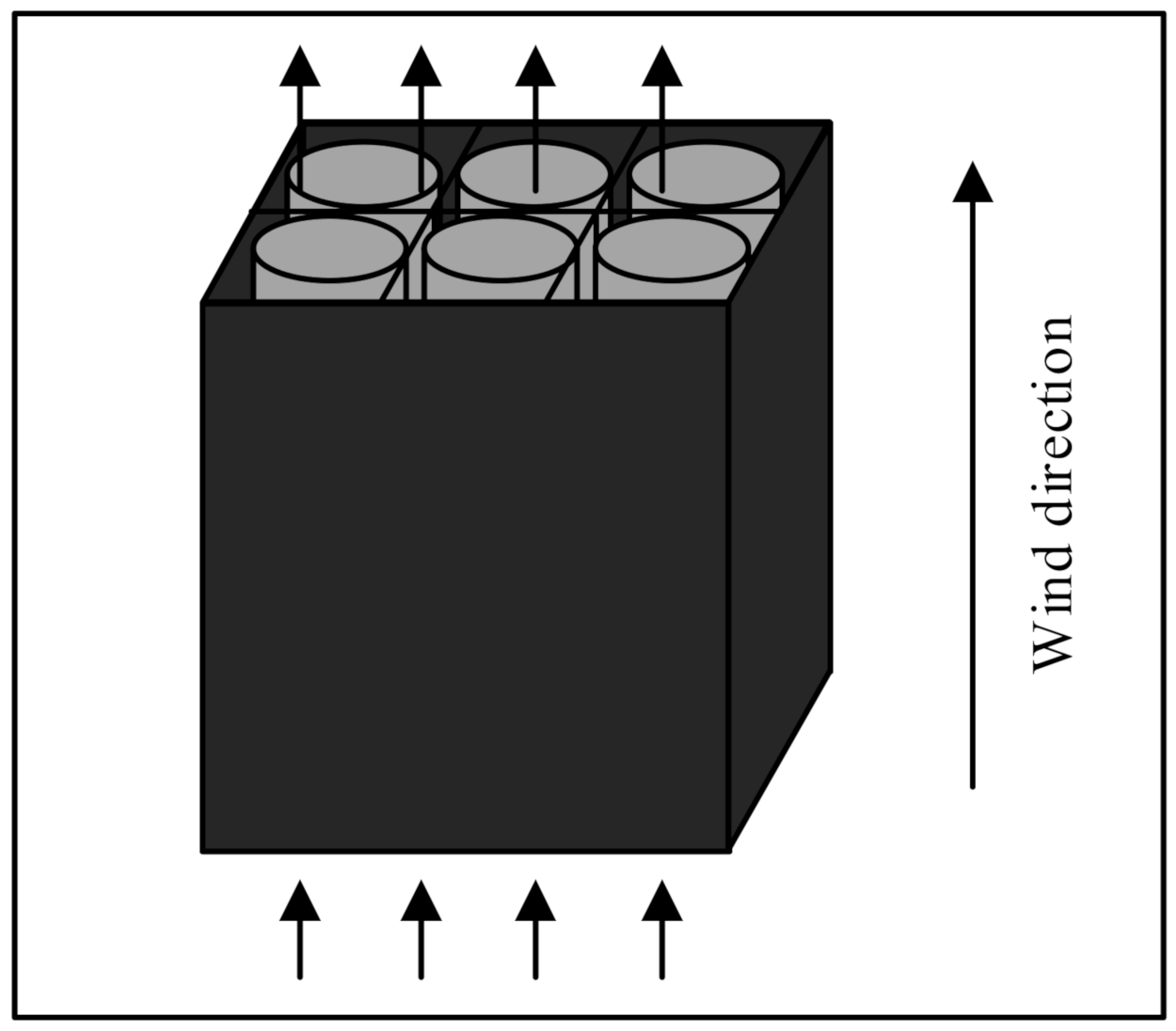

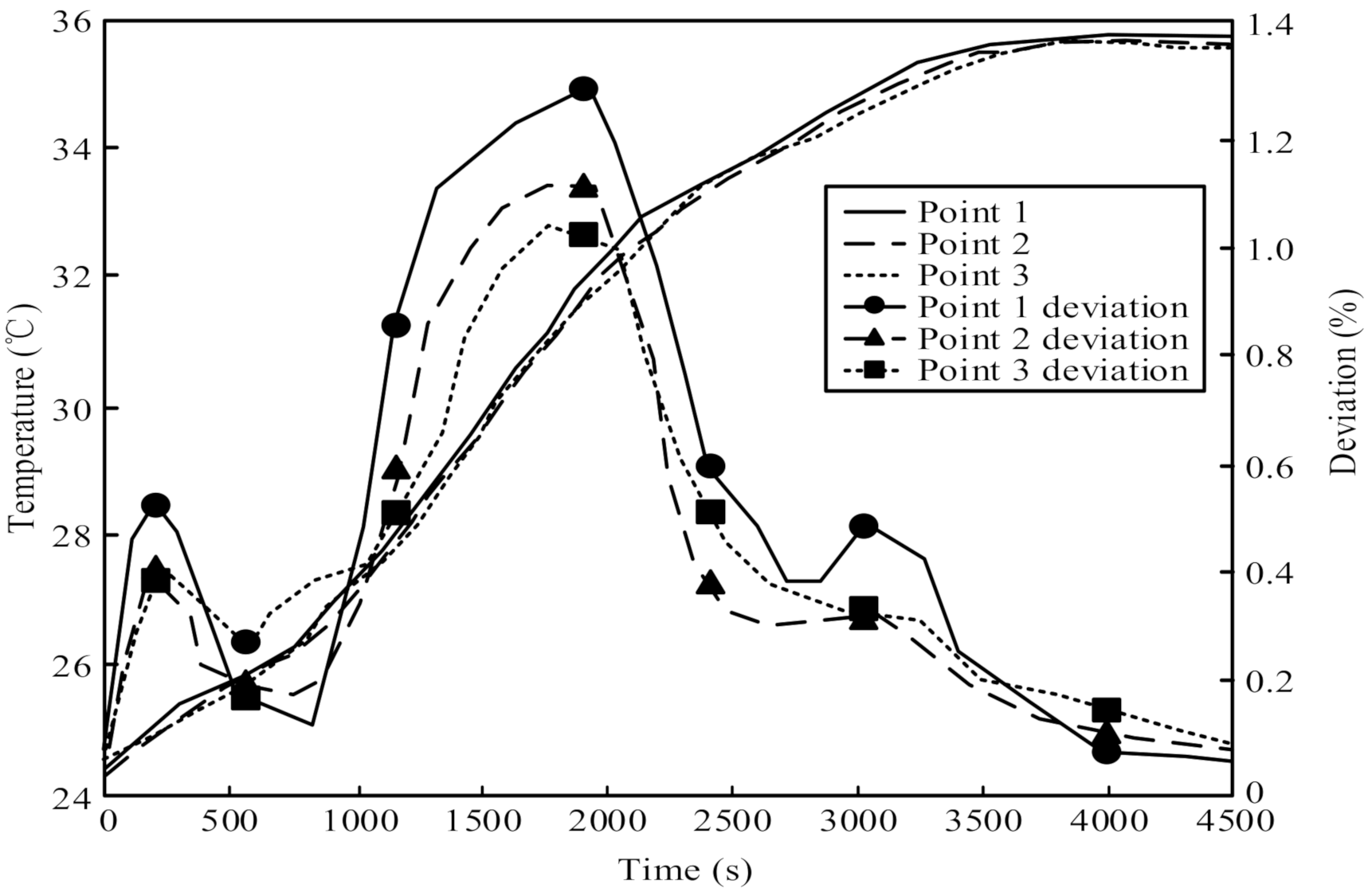
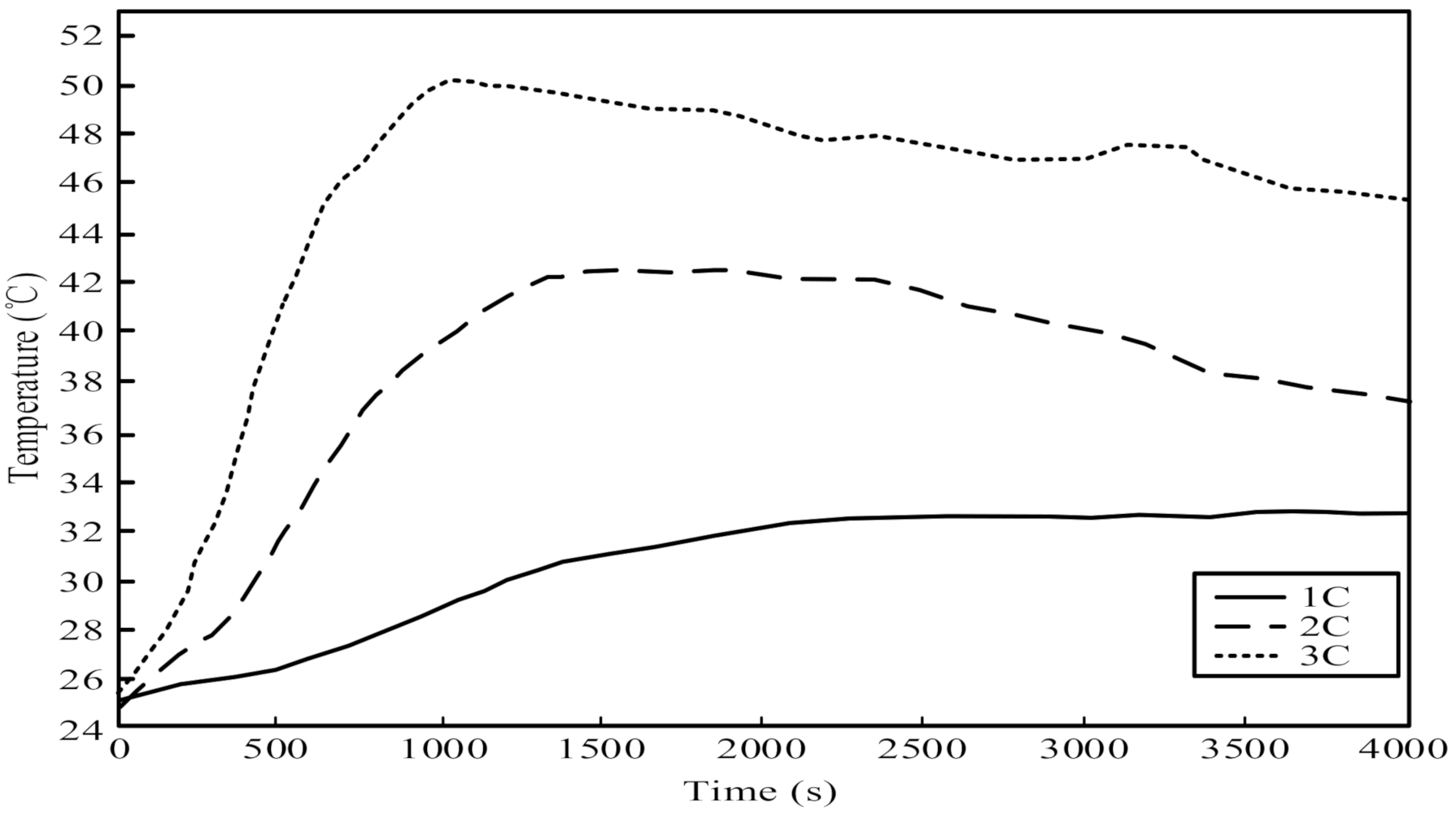
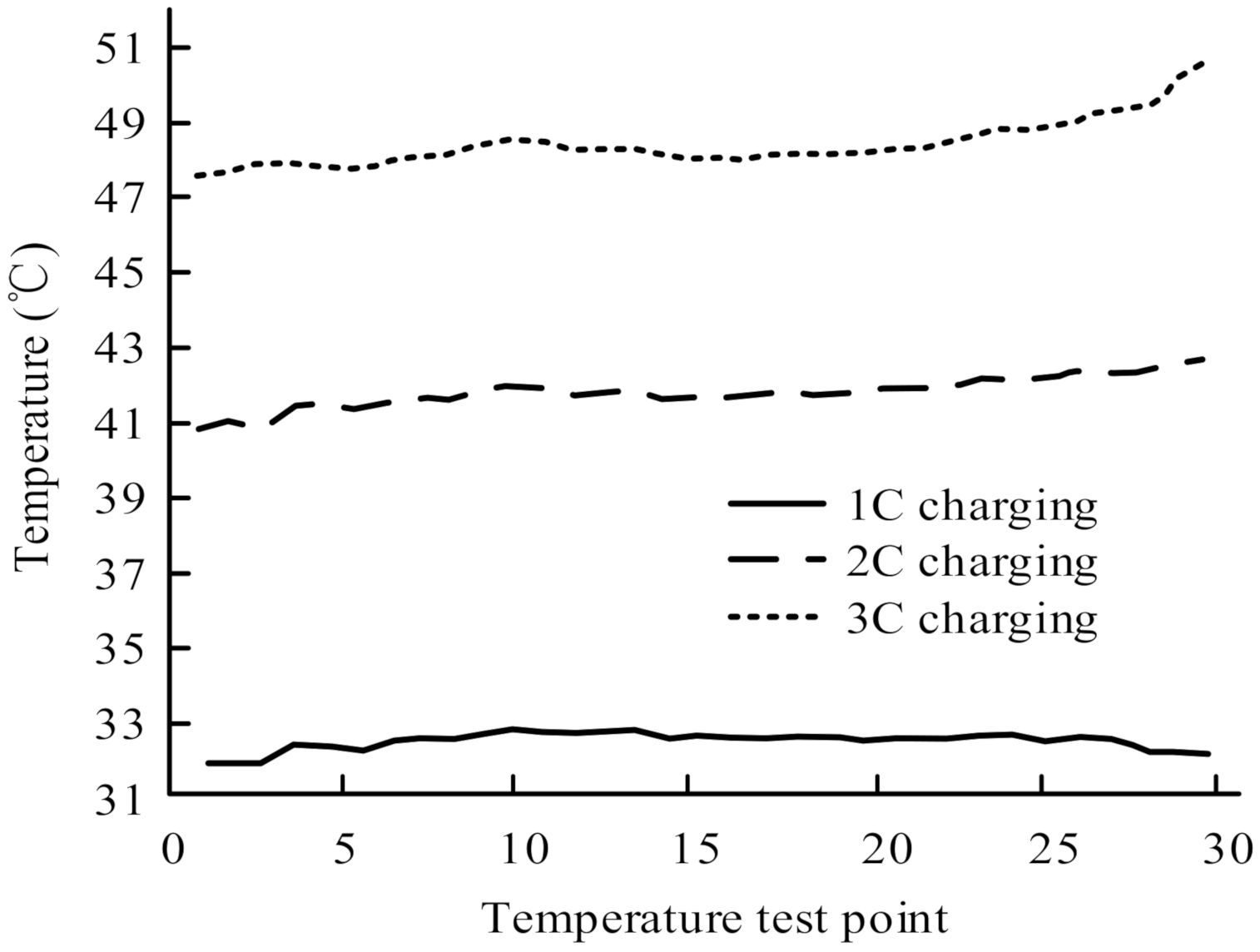



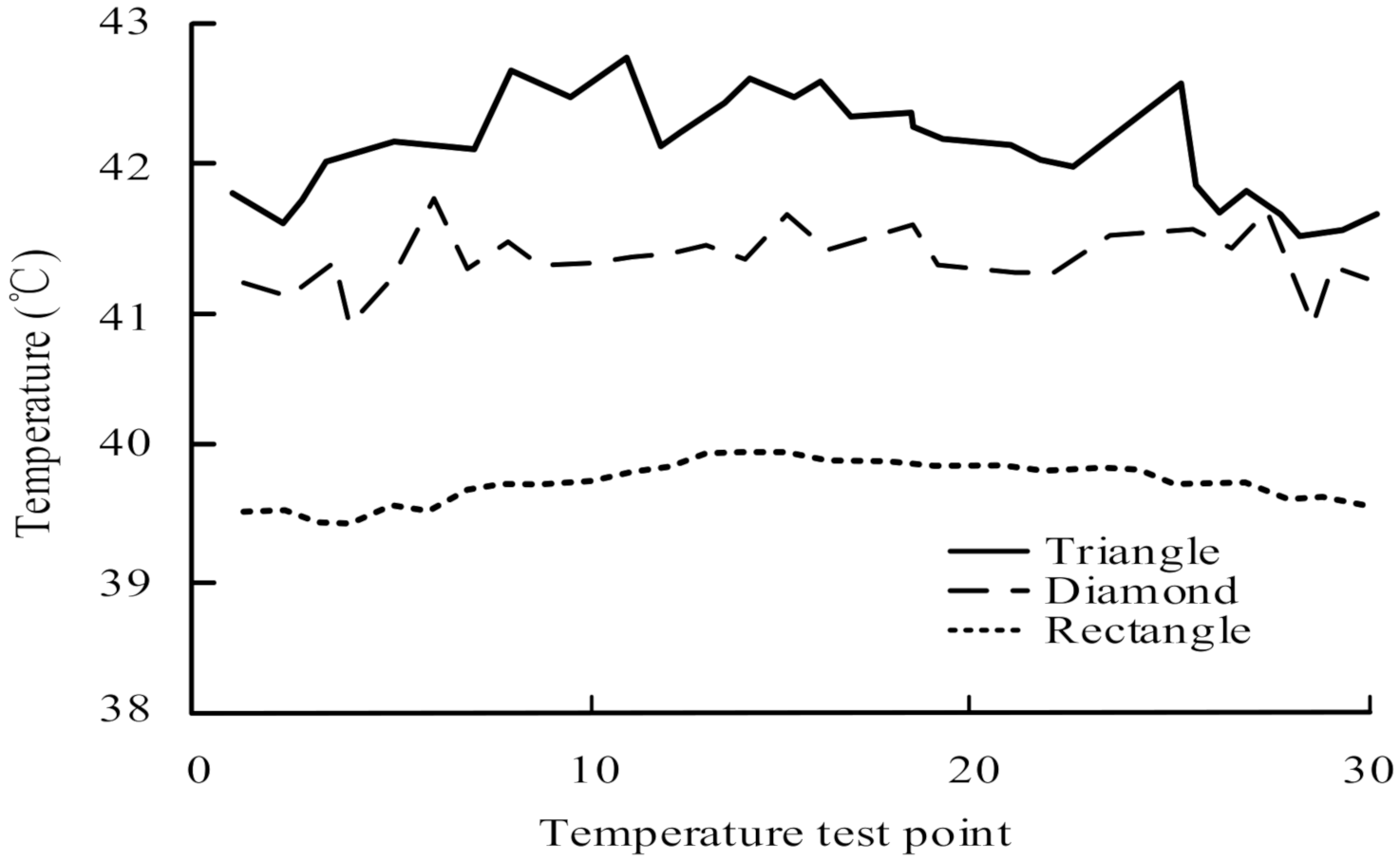
Publisher’s Note: MDPI stays neutral with regard to jurisdictional claims in published maps and institutional affiliations. |
© 2022 by the authors. Licensee MDPI, Basel, Switzerland. This article is an open access article distributed under the terms and conditions of the Creative Commons Attribution (CC BY) license (https://creativecommons.org/licenses/by/4.0/).
Share and Cite
Gao, Y.; Ji, W.; Chen, X. Numerical Study on Thermal Management of Air-Cooling Model for Diamond, Triangular and Rectangular Lithium-Ion Batteries of Electric Vehicles. Processes 2022, 10, 1104. https://doi.org/10.3390/pr10061104
Gao Y, Ji W, Chen X. Numerical Study on Thermal Management of Air-Cooling Model for Diamond, Triangular and Rectangular Lithium-Ion Batteries of Electric Vehicles. Processes. 2022; 10(6):1104. https://doi.org/10.3390/pr10061104
Chicago/Turabian StyleGao, Yun, Wujun Ji, and Xiaoqiang Chen. 2022. "Numerical Study on Thermal Management of Air-Cooling Model for Diamond, Triangular and Rectangular Lithium-Ion Batteries of Electric Vehicles" Processes 10, no. 6: 1104. https://doi.org/10.3390/pr10061104
APA StyleGao, Y., Ji, W., & Chen, X. (2022). Numerical Study on Thermal Management of Air-Cooling Model for Diamond, Triangular and Rectangular Lithium-Ion Batteries of Electric Vehicles. Processes, 10(6), 1104. https://doi.org/10.3390/pr10061104




